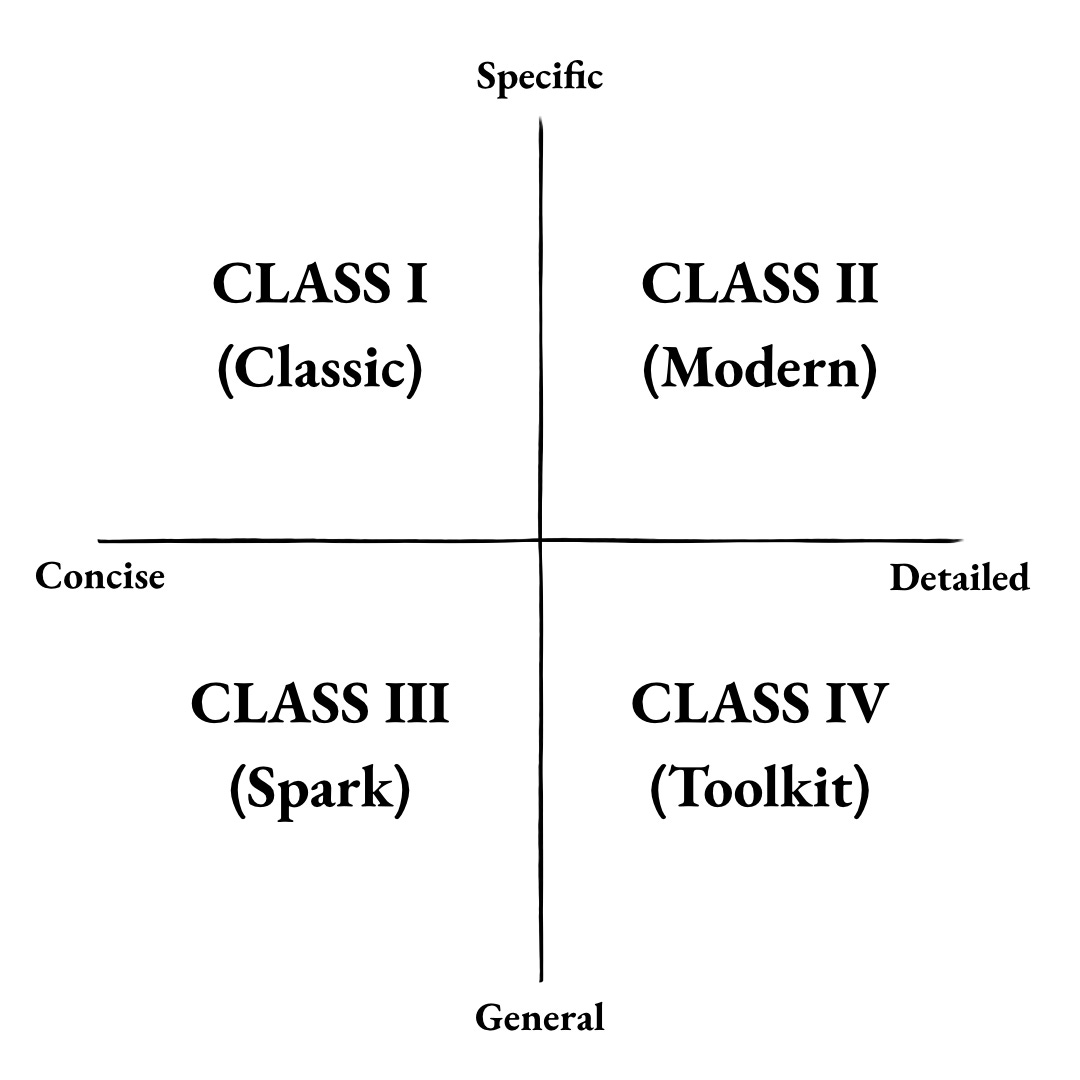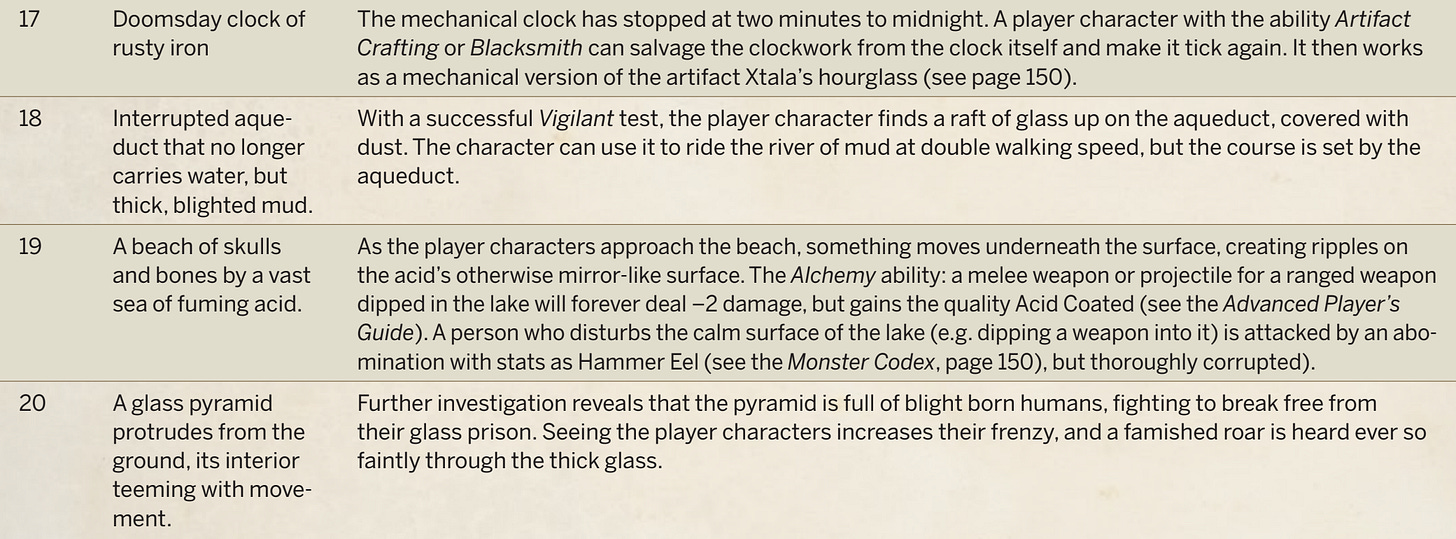Random table ramblings
MurkMail Premium Issue 15
This MurkMail Premium issue has a paywall break, allowing our non-paying readers to check out the first parts of the this article!I want to talk about random tables. Which means this is going to be looooooong (3000 words so BUCKLE UP MURKLINGS). Here’s a road map of what I’m covering.
Why I like random tables.
I want to talk about classifying random tables into different types.
With that classification, I’ll talk about what I think the pro/cons of each class of table are and what I think they are suited to.
I’ll give a quick summary of what I use each class of table for.
We’re going to skip the prose and d6 table today due to the scope of this piece.
Why I like random tables
Random tables often provoke strong opinions and reactions in the ttrpg communtiy. If I’m honest, I don’t want to delve into those arguments. I think for this article (essay?) it’s more helpful to understand why I like them.
Simulationism: I enjoy that random tables can help mechanically support a living world that is moving independently of the players. They fill game worlds with situations and events, making unpredictability (which is very real) a core feature of gameplay. Not all random tables have this purpose in mind, but they can do this well.
Pressure: Uncertainty in all forms creates tension and pressure for the players. Whether it’s rolling on a wounds table or a classic encounter table, it creates drama. Uncertainty can also push players to act.
Emergent narrative: Random tables throw spanners in the works, keeping situations and stories fresh. They stop you falling into the trap of ‘shape the story into what you have in your head’.
Efficient and prep friendly: Random tables are an efficient prep tool. In short: you just come up with a host of thematic ideas. Sure, making a really good random table definitely takes effort and it’s ideal if you have some cross-linking, but it’s a very effective and efficient way to prepare content.
Structured improvisation: Random tables can provide a springboard for better improvisation vs. improvising from thin-air. They can keep you on a thematic track and lessen your GM workload.
Breaking patterns: Random tables can throw new ideas at you in a digestable format, helping you change things up from your usual GM standbys.
Multi-purpose: It’s great when a tool can be used for multiple things: encounter tables, faction events, locations, and wound effects etc. Structuring ideas in rollable tables is applicable to many ttrpg problems.
Random tables are great but they come in all shapes and sizes, and part of being a good GM is knowing what different tools are for. So in an effort to organise my tool cabinet so to speak, I decided to split random tables into 4 classes.
Classes of random table
This isn’t about the number of entries or what the table is about, since that isn’t really meaningful in terms of classification. In my opinion, there are two variables that we can measure for all random tables that matter.
Concise - Detailed: How much information is in the entries of the table. A very detailed entry might be a multi-line paragraph, a very concise entry could be a single word or phrase.
Specific - General: How tailored are the entries to a specific setting, genre, or adventure. A general table might be a table of general faction conflict types. A specific table could reference faction dynamic changes for a particular adventure, it wouldn’t make sense out of context.
With that, we can make a little chart!
We end up with four quadrants, which provides us with four classes of table. Let’s go through each one.
CLASS I (Classic): This is where the content of the tables is short but tailored to a specific setting or adventure. The easiest example is kind of encounter tables you find in traditional adventure modules, like this one from Willow.
The entries are light on detail (concise), but these monsters have been selected for this adventure (specific). A table of items would be another example, like this one from Eco Mofos.
CLASS II (Modern): These are tables for settings and adventures (specific) where the content is expanded to include a more detailed situation. This example is from Symbaroum’s GM guide.
This is more common in products that want to provide you with something more gameable and detailed from the off. Stuff like encounters with much more detail, rollable locations, tables of effects for corruption or magic mishaps.
As a maximalist example, check out these colossal random encounter entries in Forbidden Lands’ d66 encounter table.
You can also see how some Class II tables are suited to reuse, like this table of Cyberpunk transportation methods from MurkMail Premium Issue 14:
You can get a table like this every two weeks when you join MurkMail Premium (get a 7-day free trial).
CLASS III (Spark): Chris McDowall is one of the proponents of this style of table, where single words or short phrases are used as general inspiration. This is a set of spark tables from Mythic Bastionland.
Spark tables are seen in NSR and story game products a lot, they are designed to inspire you and fuel improvisation or prep. You can find them in Blades in the Dark too.
CLASS IV (Toolkit): These are tables of template style ideas that can be applied very broadly (general) but provide more than a spark table (detailed). This is an example from Worlds Without Number.
These give more concrete ideas that can be applied more broadly, and are often intended for game preparation.
The classifications are quite broad, spark tables for instance might contain a general phrase which is more detailed than a single word, but not venture all the way to toolkit territory. As with all classifications, this isn’t a perfect system.
Let’s dig into each class. I want to think about the following things for each, then draw some conclusions.
The metrics
I’m going to analyse each class of table based on 5 key aspects.
Usability: How quick and easy is the table to use (especially in game)?
Flexibility: How malleable is the information the table presents to improvisation?
Gameability: How immediately gameable is the information the table presents?
Reusability: How much can the content of the table be reused?
Makeability: How easy is it to make one?
Looking at these will help us understand the strengths and weaknesses of each class of table.
Keep reading with a 7-day free trial
Subscribe to MurkMail to keep reading this post and get 7 days of free access to the full post archives.











